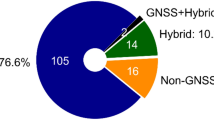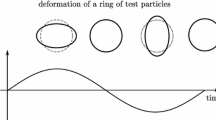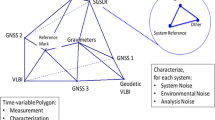Abstract
This paper answers how multiple satellites are seen from the ground. This question is inspired by space-advertising, a public exhibition in the night sky using a dot matrix of satellites that are bright enough to be seen by the naked eye. Thus, it is important for space advertisement that the specific dot matrix is seen. Moreover, the stability of the dot matrix during a visible span is very valuable. To stabilize the dot matrix, this study formulates an apparent position of a dot from a representative dot seen from the ground. The formulation, linear functions of a set of relative orbital elements, reveals the appearance of the dot matrix. The proposed relative variable in the formulation drives the instability of the dot matrix, thereby revealing an initial stable configuration of deputies from a chief. The arbitrary dot matrix designed using the configuration is stable even at low elevations without orbital control during the visible span.

Similar content being viewed by others
Abbreviations
- a :
-
semi-major axis (km)
- e :
-
eccentricity
- El :
-
elevation (deg)
- f :
-
true anomaly (rad)
- h :
-
altitude of observer (m)
- i :
-
inclination (deg)
- L :
-
direction cosine
- l :
-
apparent distance (rad)
- M :
-
mean anomaly (deg)
- n :
-
mean motion (rad/s)
- R :
-
component of transition matrix
- R :
-
transition matrix
- r :
-
geocentric distance (km)
- r IJK :
-
position vector in the IJK system (km)
- s :
-
geocentric distance of observer (km)
- s :
-
observer vector (km)
- t :
-
time (s)
- t ME :
-
time at maximum elevation (s)
- u :
-
argument of latitude (rad)
- u M :
-
mean argument of latitude (rad)
- α t :
-
topocentric right ascension (rad)
- γ :
-
rotation angle (rad)
- δ t :
-
topocentric declination (rad)
- ε :
-
scale
- θ :
-
apparent angle (rad)
- λ :
-
longitude of observer (deg)
- ρ :
-
range distance (km)
- ρ :
-
range vector (km)
- φ :
-
latitude of observer (deg)
- Ω :
-
right ascension of the ascending node (deg)
- ω :
-
argument of perigee (deg)
- 0:
-
initial value
- 1:
-
first component of a vector
- 2:
-
second component of a vector
- 3:
-
third component of a vector
- j :
-
vector component number: 1,2, and 3
- PCO:
-
projected circular orbit
- ROEs:
-
relative orbital elements
References
Santoni, F., Seitzer, P., Cardona, T., Locatelli, G., Marmo, N., Masillo, S., Morfei, D., Piergentili, F. Optical tracking and orbit determination performance of self-illuminated small spacecraft: LEDSAT (LED-based SATellite). Advances in Space Research, 2018, 62(12): 3318–3334.
Maley, P. D., Pizzicaroli, J. C. The visual appearance of the Iridium® satellites. Acta Astronautica, 2003, 52(8): 629–639.
Koshelev, V., Melnikov, V. Large Space Structures Formed by Centrifugal Forces. Boca Raton, Florida, USA: CRC Press, 1998.
Nar, D., Kotecha, R. Optimal waypoint assignment for designing drone light show formations. Results in Control and Optimization, 2022, 9: 100174.
Huebert, J., Block, W. In defense of advertising in space. In: Outer Space: Science and Law. Kumar, P. S. V., Ed. Hyderabad, India: The Icfai University Press, 2009.
O’Brien, Z. Advertising in space: Sales at the outer limits. In: Commercial Space Exploration. Galliott, J., Ed. New York: Routledge, 2016: 91–106.
Biktimirov, S., Belyj, G., Pritykin, D. Satellite formation flying for space advertising: From technically feasible to economically viable. Aerospace, 2022, 9(8): 419.
Biktimirov, S., Ivanov, D., Pritykin, D. A satellite formation to display pixel images from the sky: Mission design and control algorithms. Advances in Space Research, 2022, 69(11): 4026–4044.
Emelyanov, N. V., Kondratyev, B. P. Determining the orbit from five relative apparent positions. Icarus, 2022, 383: 115060.
Yanoff, M., Duker, J. S. Ophthalmology, 2nd edn. Elsevier, 2004.
Kinoshita, H. Celestial Mechanics and Orbital Dynamics. University of Tokyo Press, 1998.
Vallado, D. A. Fundamentals of Astrodynamics and Applications. McGraw-Hill, 1997.
Sullivan, J., Grimberg, S., D’Amico, S. Comprehensive survey and assessment of spacecraft relative motion dynamics models. Journal of Guidance, Control, and Dynamics, 2017, 40(8): 1837–1859.
D’Amico, S. Autonomous formation flying in low earth orbit. Ph.D. Thesis. Delft, the Netherlands: Delft University of Technology, 2010.
D’Amico, S. Relative orbital elements as integration constants of Hill’s equations. TN 05-08. DLR, 2005. Information on https://www.researchgate.net/publication/265495397_Relative_Orbital_Elements_as_Integration_Constants_of_Hill%27s_Equations
Acknowledgements
The authors would like to acknowledge Mr. Kazunobu Takahashi, a graduate student at Kyushu University, Japan, for his useful advice on this study and writing.
Author information
Authors and Affiliations
Corresponding author
Ethics declarations
The authors have no competing interests to declare that are relevant to the content of this article.
Additional information
Kenta Nakajima is a graduate student in Department of Aeronautics and Astronautics in Graduate School of Engineering at Kyushu University, Japan. His main research areas include space advertisement and relative motion. E-mail: nakajima.kenta.252@s.kyushu-u.ac.jp
Yasuhiro Yoshimura received his Ph.D. degree from Kyushu University in 2013. He is currently an assistant professor in Kyushu University. His research interests are attitude control and state estimate for space situational awareness. E-mail: yoshimura.yasuhiro.650@m.kyushu-u.ac.jp
Hongru Chen is an assistant professor at Kyushu University. She received her bachelor degree from Northwestern Polytechnical University, China, in 2010, and her Ph.D. degree from Kyushu University in 2015, both in aerospace engineering. She finished her Ph.D. thesis at ISAS/JAXA, once worked at the Chinese Academy of Sciences and IMCCE/Paris Observatory, and participated in JAXA and CNES planetary projects, such as PROCYON, DESTINY, and MMX. Her research interests lie in astrodynamics, orbit design, nano-satellite engineering, and atmosphere modeling. E-mail: hongru.chen@hotmail.com
Toshiya Hanada studied aeronautics and applied mechanics at Kyushu University, and graduated with the degree of Doctor of Engineering in 1994, and then joined Kyushu University as a research associate. Currently he is a professor at the Department of Aeronautics and Astronautics, and Vice Director at the International Centre for Space and Planetary Environmental Science. He is teaching astrodynamics and spacecraft technology. His research interest is to confirm whether we really must clean up the space junks out there as in ПAANHTEΣ, a Japanese hard science fiction manga written and illustrated by Makoto Yukimura. To figure out the right answer to his question, he is working on projects that contribute to the long-term sustainability of outer space activities, space debris modeling, and space situational awareness. E-mail: hanada.toshiya.293@m.kyushu-u.ac.jp
Rights and permissions
About this article
Cite this article
Nakajima, K., Yoshimura, Y., Chen, H. et al. How are multiple satellites seen from the ground? Relative apparent motion and formation stabilization. Astrodyn 8, 121–134 (2024). https://doi.org/10.1007/s42064-023-0180-6
Received:
Accepted:
Published:
Issue Date:
DOI: https://doi.org/10.1007/s42064-023-0180-6




